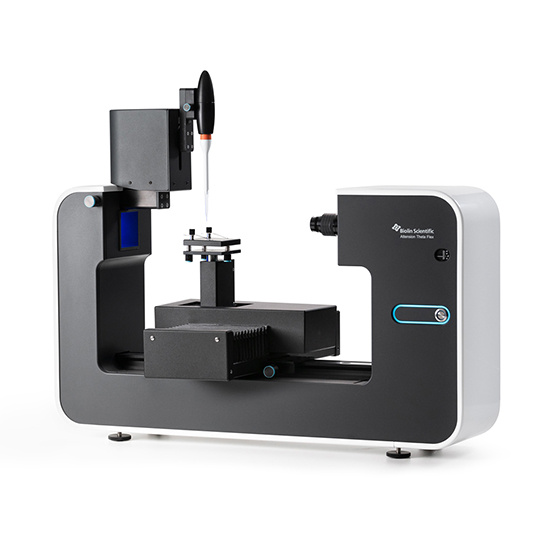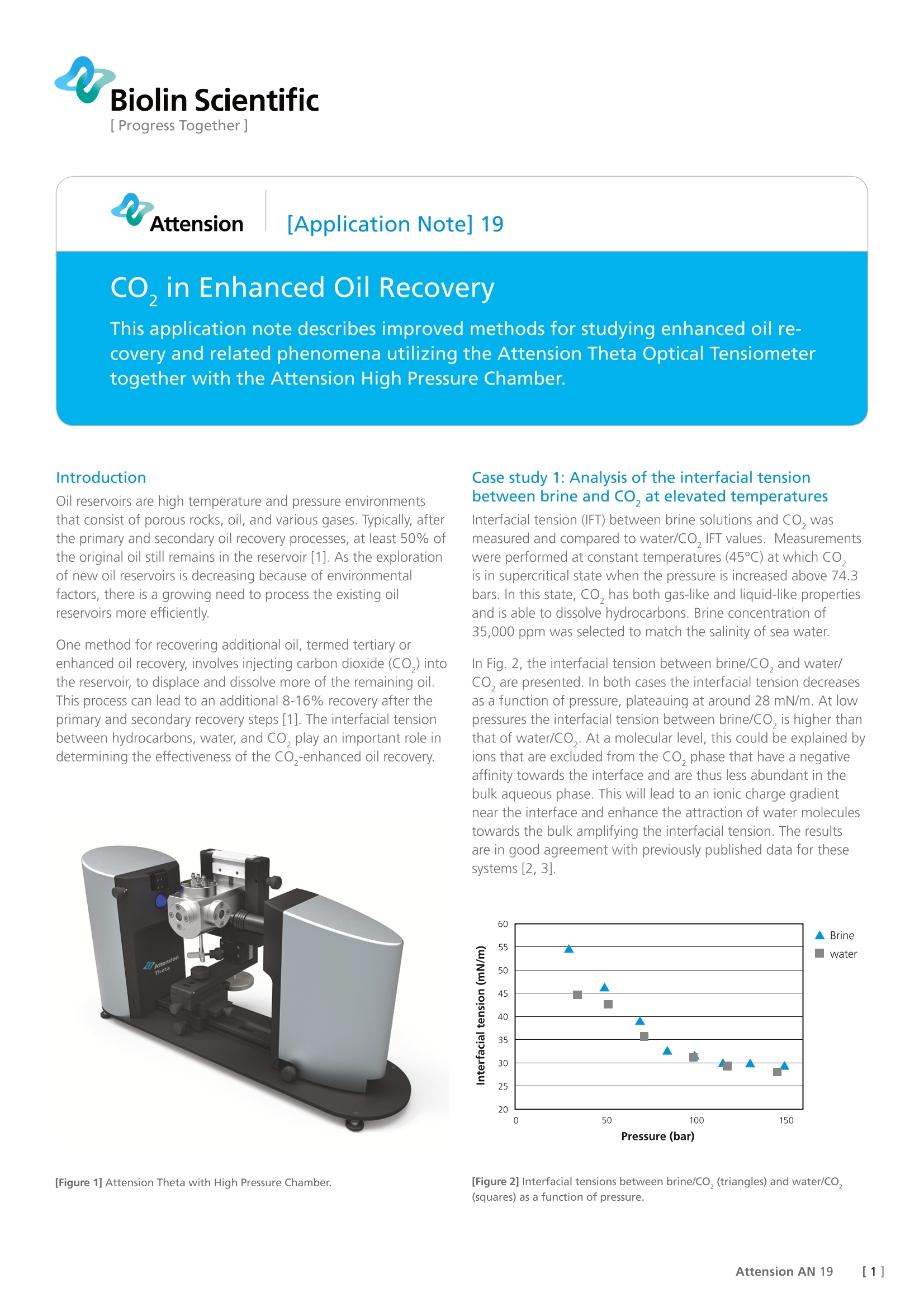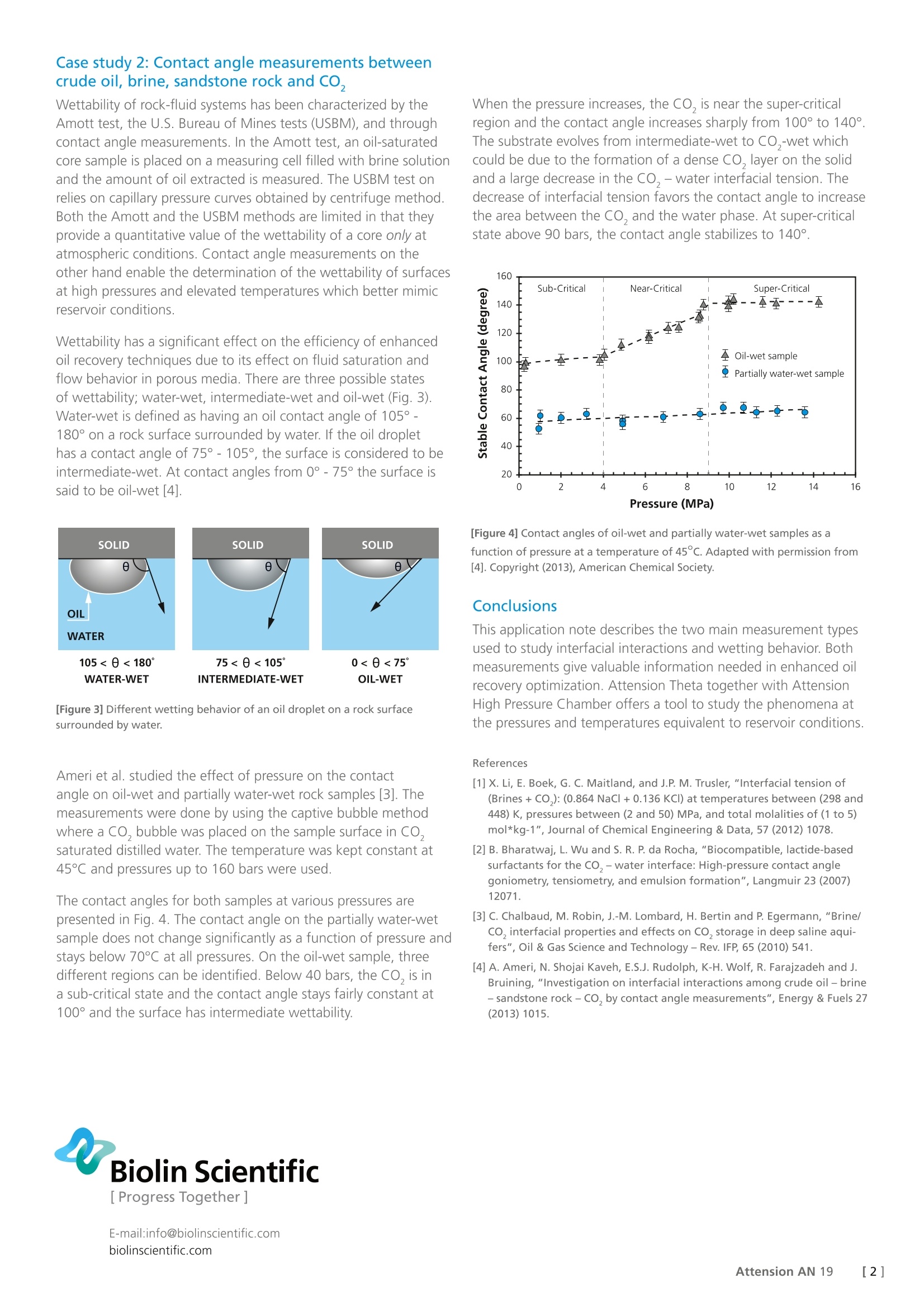
方案详情
文
原油一般都是蕴藏高温高压环境中,并伴随着多孔石头,其他成分油品和天然气共存。通常经过一次采油和二次采油之后,仍旧有至少50%的原油存在于油田中没有被充分采集。伴随着新的油田的开发数量的降低,环境保护意识的加强,旧油田的重复采集逐渐被重视。在重复采集的过程中,二氧化碳注入油井可以替换并溶解更多的石油,提高采收率。这篇文章使用光学接触角仪结合高压模块研究油田采收率。
方案详情

Biolin Scientific[ Progress Together] [Application Note] 19 CO, in Enhanced Oil Recovery This application note describes improved methods for studying enhanced oil re-covery and related phenomena utilizing the Attension Theta Optical Tensiometer together with the Attension High Pressure Chamber. Introduction Oil reservoirs are high temperature and pressure environmentsthat consist of porous rocks, oil, and various gases. Typically, afterthe primary and secondary oil recovery processes, at least 50% ofthe original oil still remains in the reservoir [1]. As the explorationof new oil reservoirs is decreasing because of environmentalfactors, there is a growing need to process the existing oilreservoirs more efficiently. One method for recovering additional oil, termed tertiary orenhanced oil recovery, involves injecting carbon dioxide (CO,) intothe reservoir, to displace and dissolve more of the remaining oil.This process can lead to an additional 8-16% recovery after theprimary and secondary recovery steps [1]. The interfacial tensionbetween hydrocarbons, water, and CO, play an important role indetermining the effectiveness of the CO,-enhanced oil recovery. [Figure 1] Attension Theta with High Pressure Chamber. Case study 1: Analysis of the interfacial tensionbetween brine and CO, at elevated temperatures Interfacial tension (IFT) between brine solutions and CO, wasmeasured and compared to water/CO, IFT values. Measurementswere performed at constant temperatures (45C) at which CO,is in supercritical state when the pressure is increased above 74.3bars. In this state, CO, has both gas-like and liquid-like propertiesand is able to dissolve hydrocarbons. Brine concentration of35,000 ppm was selected to match the salinity of sea water. In Fig. 2, the interfacial tension between brine/CO, and water/CO, are presented. In both cases the interfacial tension decreasesas a function of pressure, plateauing at around 28 mN/m. At lowpressures the interfacial tension between brine/CO, is higher thanthat of water/CO,. At a molecular level, this could be explained byions that are excluded from the CO, phase that have a negativeaffinity towards the interface and are thus less abundant in thebulk aqueous phase. This will lead to an ionic charge gradientnear the interface and enhance the attraction of water moleculestowards the bulk amplifying the interfacial tension. The resultsare in good agreement with previously published data for thesesystems [2, 3]. ▲Brine ■ water [Figure 2] Interfacial tensions between brine/CO, (triangles) and water/CO,(squares) as a function of pressure. Case study 2: Contact angle measurements betweencrude oil, brine, sandstone rock and CO, Wettability of rock-fluid systems has been characterized by theAmott test, the U.S. Bureau of Mines tests (USBM), and throughcontact angle measurements. In the Amott test, an oil-saturatedcore sample is placed on a measuring cell filled with brine solutionand the amount of oil extracted is measured. The USBM test onrelies on capillary pressure curves obtained by centrifuge method.Both the Amott and the USBM methods are limited in that theyprovide a quantitative value of the wettability of a core only atatmospheric conditions. Contact angle measurements on theother hand enable the determination of the wettability of surfacesat high pressures and elevated temperatures which better mimicreservoir conditions. Wettability has a significant effect on the efficiency of enhancedoil recovery techniques due to its effect on fluid saturation andflow behavior in porous media. There are three possible statesof wettability; water-wet, intermediate-wet and oil-wet (Fig. 3).Water-wet is defined as having an oil contact angle of 105°-180° on a rock surface surrounded by water. If the oil droplethas a contact angle of 75°-105°, the surface is considered to beintermediate-wet. At contact angles from 0°-75° the surface issaid to be oil-wet [4]. [Figure 3] Different wetting behavior of an oil droplet on a rock surfacesurrounded by water. Ameri et al. studied the effect of pressure on the contactangle on oil-wet and partially water-wet rock samples [3]. Themeasurements were done by using the captive bubble methodwhere a CO, bubble was placed on the sample surface in CO,saturated distilled water. The temperature was kept constant at45℃ and pressures up to 160 bars were used. The contact angles for both samples at various pressures arepresented in Fig. 4. The contact angle on the partially water-wetsample does not change significantly as a function of pressure andstays below 70℃ at all pressures. On the oil-wet sample, threedifferent regions can be identified. Below 40 bars, the CO, is ina sub-critical state and the contact angle stays fairly constant at100° and the surface has intermediate wettability. When the pressure increases, the CO, is near the super-criticalregion and the contact angle increases sharply from 100° to 140°.The substrate evolves from intermediate-wet to CO,-wet whichcould be due to the formation of a dense CO, layer on the solidand a large decrease in the CO, - water interfacial tension. Thedecrease of interfacial tension favors the contact angle to increasethe area between the CO, and the water phase. At super-criticalstate above 90 bars, the contact angle stabilizes to 140°. [Figure 4] Contact angles of oil-wet and partially water-wet samples as afunction of pressure at a temperature of 45C. Adapted with permission from[4]. Copyright (2013), American Chemical Society. Conclusions This application note describes the two main measurement typesused to study interfacial interactions and wetting behavior. Bothmeasurements give valuable information needed in enhanced oilrecovery optimization. Attension Theta together with AttensionHigh Pressure Chamber offers a tool to study the phenomena atthe pressures and temperatures equivalent to reservoir conditions. ( References ) ( [ 1] X. L i, E. Boek, G. C. Maitland, and J.P. M. Tr u sler, "I n terfacial tension of (Brines + CO,): (0.864 NaCl +0.136 KCl) at temperatures between (298 and 448) K , pressures between (2 and 5 0) MPa , and t otal mola l ities of (1 to 5 ) mol*kg-1", Jour n al o f C hemical Engineeri ng & D a ta, 57 (2012) 1078. ) ( [ 2] B. Bharatwaj, L. Wu and S . R. P . da Rocha, " Biocompat ib le, la c tide-based surfactants for the CO, -water i n terface: High-pr es sure contact angle g oniometry, tensiometry, and emulsion f o rmatio n ", L a ngmuir 23 (2007) 12071. ) [3]C. Chalbaud, M. Robin, J.-M. Lombard, H. Bertin and P. Egermann,"Brine/CO, interfacial properties and effects on CO, storage in deep saline aqui-fers", Oil & Gas Science and Technology- Rev. IFP, 65 (2010) 541. [4] A. Ameri, N. Shojai Kaveh, E.S.J. Rudolph, K-H. Wolf, R. Farajzadeh and J.Bruining, "Investigation on interfacial interactions among crude oil -brine-sandstone rock- CO, by contact angle measurements", Energy & Fuels 27(2013)1015. Biolin Scientific [ Progress Together ] E-mail:info@biolinscientific.combiolinscientific.com []Attension AN
确定


还剩1页未读,是否继续阅读?
瑞典百欧林科技有限公司为您提供《油田中采收率检测方案 》,该方案主要用于原油中采收率检测,参考标准--,《油田中采收率检测方案 》用到的仪器有Attension Theta Flex 光学接触角仪、Theta Lite 光学接触角仪、Theta QC 光学接触角仪
相关方案
更多
该厂商其他方案
更多











